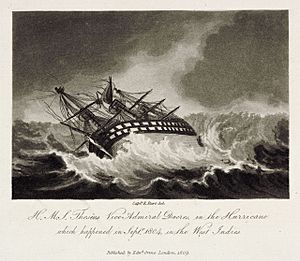HMS Theseus (1786) facts for kids

HMS Theseus in the 1804 Antigua–Charleston hurricane.
|
|
Quick facts for kids History |
|
|---|---|
| Name | HMS Theseus |
| Namesake | Theseus |
| Ordered | 11 July 1780 |
| Builder | Perry, Blackwall Yard |
| Laid down | 3 September 1783 |
| Launched | 25 September 1786 |
| Fate | Broken up, 1814 |
| Notes | |
| General characteristics | |
| Class and type | Culloden-class ship of the line |
| Tons burthen | 1660 (bm) |
| Length | 170 ft (52 m) (gundeck) |
| Beam | 47 ft 2 in (14.38 m) |
| Depth of hold | 19 ft 11 in (6.07 m) |
| Propulsion | Sails |
| Sail plan | Full-rigged ship |
| Armament |
|
HMS Theseus was a powerful warship of the Royal Navy. It was a 74-gun third-rate ship of the line. This means it had 74 cannons and was a large, important ship.
Theseus was one of eight similar ships. They were all designed by Thomas Slade. The ship was built in London at Blackwall Yard. It was launched on September 25, 1786.
Contents
Key Battles and Service
Theseus was involved in many important naval battles. It served the British Royal Navy for many years.
Battle of Santa Cruz de Tenerife (1797)
In 1797, Theseus was the main ship for Admiral Horatio Nelson. This was during the Battle of Santa Cruz de Tenerife. Captain Ralph Willett Miller was in charge of the ship day-to-day.
The British forces lost this battle. Admiral Nelson was hurt on Theseus by a musket ball. This injury led to his right arm being amputated. Even after this defeat, the crew of Theseus stayed in good spirits.
Captain Miller made sure the crew stayed healthy. He ordered fresh onions and lemons for daily meals. This helped prevent scurvy, a common illness at sea. He also kept the ship clean to stop mold.
Battle of the Nile (1798)
In 1798, Theseus fought in the important Battle of the Nile. Captain Ralph Willett Miller was still its commander. The British Royal Navy was up against the French fleet.
The French had more powerful ships. Their fleet included the huge 118-gun L'Orient. They also had three 80-gun ships and nine 74-gun ships. The British had thirteen 74-gun ships and one 50-gun ship.
During the battle, Theseus helped other British ships. It assisted Alexander and Majestic. These ships were being attacked by several French warships.
The French frigate Artemise gave up to the British. Its crew then set the ship on fire. This was to stop the British from taking it. Two other French ships, Heureux and Mercure, got stuck. They surrendered after a short fight with three British ships, including Theseus.
The Royal Navy won this battle. It was a big success for Admiral Nelson. The victory cut off supplies to the French army in Egypt. This army had planned to threaten British India.
The battle had many casualties. The French lost over 1,700 killed and 600 wounded. About 3,000 French sailors were captured. The British had 218 dead and 677 wounded. Nine French warships were captured, and two were destroyed. Two French ships managed to escape. Theseus lost five sailors and had thirty wounded.
Siege of Acre (1799)
Theseus had a difficult time during the Siege of Acre in 1799. Captain Ralph Willett Miller was still in command. On May 13, 1799, the ship arrived near Caesarea.
Captain Miller prepared the ship to bombard Acre the next morning. A lot of ammunition was brought onto the deck. This included over 70 large shells.
On May 14, at 9:30 AM, the ammunition accidentally caught fire. This happened while the ship was moving. The explosion caused a fire on the deck. It also damaged the mainmast and mizzen mast. Captain Miller and 25 other men were killed. Another 45 crew members were injured.
Flames quickly spread through the ship. A second explosion destroyed parts of the ship's stern. The main mast fell over the side. Ten more men died before the fire was put out. The ship was too damaged to help with the Acre campaign.
Later Service and Fate
After being repaired, Theseus returned to service. In 1803, it took part in the Blockade of Saint-Domingue. Captain John Bligh was the commander then.
The ship also fought in the Battle of the Basque Roads in 1809. Lord Cochrane led a daring attack. He used fire ships to confuse the French fleet. Many French ships ran aground because of this attack.
The French fleet might have been completely destroyed. However, Admiral Lord Gambier hesitated to send in the main British fleet. This allowed some of the French ships to escape.
Theseus was eventually taken apart in 1814. This happened at Chatham.



